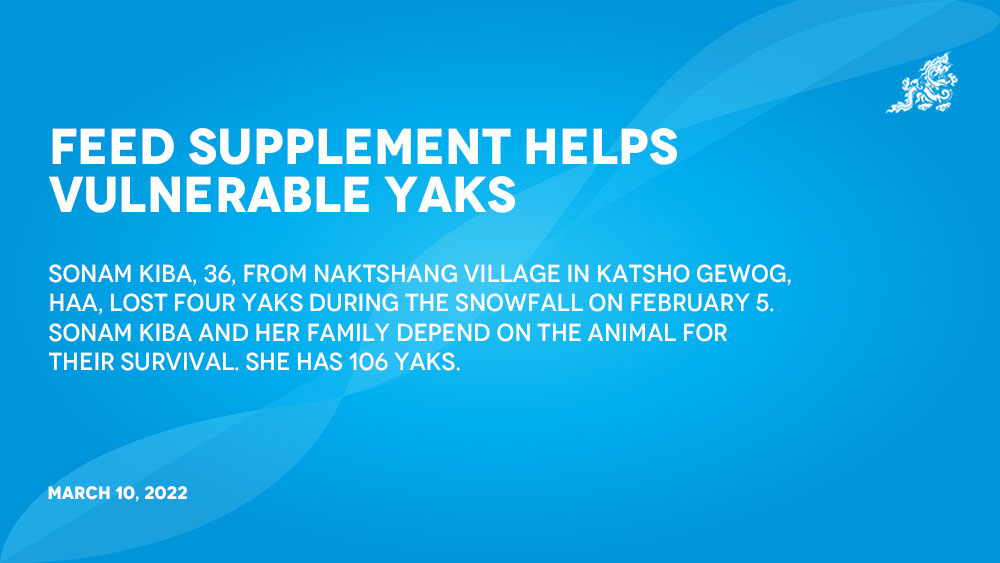Chhimi Dema
Sonam Kiba, 36, from Naktshang village in Katsho gewog, Haa, lost four yaks during the snowfall on February 5.
Sonam Kiba and her family depend on the animal for their survival. She has 106 yaks.
A yak sold among the herders fetches money ranging from Nu 25,000 to 28,0000.
“The grazing grounds were covered in heavy snowfall and the yaks starved, leading to their death,” Sonam Kiba said.
Records with the Department of Livestock show that 345 yaks died and many were missing due to the heavy snowfall measuring three to four feet in highlands of the country.
The department continues to receive death reports from the areas.
Sonam Kiba said: “The core of our livelihood is yaks. All household expenses are met through the livestock products from the animal. The animal’s well-being is important to us.”
Her other source of income, selling radish and potatoes, was challenged by the lockdowns. “I could not take the produce to the market because of the movement restrictions.”
To reduce the incidences of yak mortality, the Department of Livestock (DoL) and the National Highland Research Development Centre in Bumthang supported the yak rearing households of Haa and Bumthang with feed supplementation.
DoL on its Facebook stated: “The mortality has occurred mainly from off feed, as mere or scarce fodder and grasses available were covered under snow and a small quantity of locally formulated feed and conserved hay available with the herders could not be reached, as the yaks have dispersed far, looking for a place to feed and avoid extreme climate.”
Sonam Kiba received feed supplementation for her yaks from the department.
She said: “The feed supplementation that the government provided helps ensure the health of the animal.”
According to the department, Haa dzongkhag’s livestock officials provided feed supplement of mixed ration comprising mustard oil cake and maize flour to be fed every day for a minimum period of one month to the vulnerable yaks.
Haa has a total yak population of 4,879. The feed supplements were provided to 1,464 vulnerable yaks (including young calves below two years, pregnant and old yaks, and physically weak animals).
A total of 232 bags each of mustard oil cake and maize flour was distributed to 58 yak herders under Bji, Katsho and Eusu gewogs, sufficient enough to sustain for one month (21,955.5kgs).
According to the National Statistics Bureau, there were 40,897 yaks in the country as of 2020.
Kipchu, 52, in Sangkiri village in Eusu gewog, said that it took him a week to find 10 yaks from his herd of 100 yaks.
“None of the yaks died but most of them are feeble today. The feed has helped some to restore their strength,” he said.
Kipchu added that with no qualification or talent to earn a living, he solely depends on yaks to feed his family.
NHRDC in collaboration with National Research Development Center for Animal Nutrition processed two metric tones of organic feed and distributed them to Bumthang yak herders. In addition, two MT of feed blocks that were produced was distributed to Gasa.
Nob Tshering, 63, from Choekhor gewog, also the chairperson for the Bumthang Yak Federation, said that the snowfall this year covered the grounds making feed inaccessible for the animal.
“When yaks migrate to higher altitude, we might lose more animal because the dried fodder will be scarce, and the new grasses would not have grown,” he said.
A yak rearing family in a year earns about Nu 150,000, half of which is used for the animal’s feed and other expenses.
“Yaks are our main source of income and their well-being determines ours as well,” he added.
The feed that the government has supplied was helpful to them, Nob Tshering said, but is not enough for them to feed a high number of yaks.
All the 40 household rearing yaks in the gewog received the feed supplementation support.


